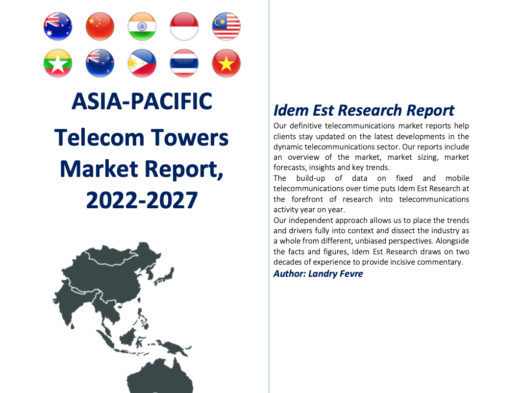Description
WHY YOU SHOULD BUY THE JAPAN TELECOMS INDUSTRY REPORT:
- Benefit from the latest market opportunities
- Understand the threats to your operations and investments and protect your company against future risks
- Gain insights on emerging trends supporting, enhancing or disrupting your activities in the market
- Get a full view of the competitive landscape to assess your market position.
- Forecasts as a key input for successful budgeting and strategic business planning in the telecoms market
- Target business opportunities and risks in the telecoms sector through our reviews of latest industry trends, regulatory changes and major deals, projects and investments
- Assess the activities, strategy and market position of your competitors, partners and clients via our Operators Profiles
The Japan Telecommunications Industry Report, 2023-2030 includes a comprehensive review of the Japanese market dynamics, market sizing, market forecasts, analysis, insights and key trends.
EXECUTIVE SUMMARY
Japan Telecoms Industry Report at a Glance
Globally, the telecommunications sector is proving to be a core and essential infrastructure service to national economies, with data infrastructure becoming critical in a connected world and will likely increasingly attract a new class of investors such as large infrastructure funds. Idem Est Research expects the Japanese telecommunications industry to remain steady thanks to the defensiveness nature of the industry, amid the political uncertainties and an uncertain economic outlook due to rising inflation.
The Japanese telecommunications market is the third-largest market in the world by revenue (USD137 billion) with four large fixed and mobile network operators that invested heavily in towers and fibre infrastructure over the past two decades despite an overall market underpinned by low economic and population growth.
Growing mobile phone penetration and high fixed broadband take-up among households will fuel future growth over the next five years.
Following the market expansion over the last 5 years, Idem Est Research forecasts subdued revenue growth growing to 2030, the diminishing impact of declining legacy voice and SMS revenue, Rakuten market entry and population decline.
The strategic and economic competition between Japan and China is at the centre of advanced technology competition and the future of global data and communications. For most developed countries in the region, gaining strategic and economic power depends heavily on having technological ascendancy, especially in data and communications.
Capex Investments
The Capex from Japanese operators is cyclical with mobile rollout leading to investments in line with the operators’ top-line growth. Capex investments peaked in 2021 while all three operators built their respective 5G mobile networks. Capex will continue growing from 2024 through to 2030, as mobile operators invest in 5G. Japan sees 5G as the backbone of a wide range of technological advances including autonomous vehicles, smart cities and Internet of Things. All three mobile operators launched 5G services in March 2020 with Rakuten launching in 2021. The Capex to GDP ratio will decline slighly during the forecast peior to 2030.
Idem Est Research projects an increase in Capex spend throughout 2024 alone by installing more 5G base stations across all cities, ramping up Japan’s 5G rollout nationwide and consolidating its 5G network leadership in terms of subscribers and availability in the country.
Operator Profiles
The Japanese three-player mobile market is a remarkably stable market, however it is about to be rocked by fourth market entrant – Rakuten Mobile – looking to follow the steps of successful new entrants launch such as Free in France and Reliance Jio in India. Rakuten has set an ambitious target of being the first cloud-native mobile network.
Between 2016 and 2022, both NTT lost revenue and EBITDA share to KDDI and Softbank over the last six years, Softbank lost some EBITDA share while cost reduction measures started to flow in 2019 with improving EBITDA and cash flow.
Mobile Subscribers and Revenue
Average annual mobile revenue growth was lower (-0.7%) than mobile service subscriptions growth (4.1%) during the period 2016-2022, highlighting the structural challenges faced by mobile operators. Declining voice & SMS revenue only partially offset by wireless data monetisation is putting pressure on ARPU, compounded by bundling discounts to stem churn.
IoT connections is a major growth driver for mobile operators, a slowdown in mobile subscriptions growth will put long term pressure, dialling up competition for the three mobile operators fighting for fewer new customers.
According to our benchmark study of mobile data pricing, Japan had among the biggest cost reduction per GB over the last 3 years, while India has the lowest rate in the world with just a few cents per GB.
Idem Est Research forecasts Rakuten could capture up to 10m subscribers in 3 years by offering lower pricing, e-Commerce bundling and other lifestyle services to its existing 100 million Rakuten customers, while KDDI and to a lesser extent NTT and Softbank already embarked on such journey.
Idem Est Research forecasts 5G mobile subscribers will represent nearly 70% subscribers of all subscriptions by 2030, 6G at 5%, 4G will represent about 25% of all connections while 3G will be shut down by the end of 2026.
Broadband Subscribers – FTTH Push to Gigabit Speeds
After over 20 years of investments in fibre infrastructure, Japan boasts one of the highest FTTH penetration in the world as well as one of the most advanced, consumer broadband products offering speeds up to 10Gbps. However, most people use 100Mbps packages which are mostly bundled with mobile services by the three dominant players, NTT, KDDI and Softbank.
Fixed broadband penetration is forecasted to grow modestly as Japan’s investments in full-fibre networks are now reaching maturity with affordable packages and increased broadband household penetration growing towards saturation.
High Penetration of FTTH
Japan boasts one of the highest FTTH penetrations in the world (85%) and offers some of the most advanced consumer broadband products with speeds up to 10Gbps. The majority of users opt for 100Mbps packages, often bundled with mobile services.
Satellite Broadband: Reshaping Connectivity
LEO and GEO Satellites
The satellite broadband sector is another area where Japan is making strides. With detailed comparisons of Low Earth Orbit (LEO) and Geosynchronous Orbit (GEO) satellites, Japan is leveraging these technologies for global coverage and low-latency communication, ideal for real-time application. By 2030, the satellite broadband subscribers in Japan are expected to reach 1 million, with the market growing at an average annual rate of 102%. This growth will be accelerated by the deployment of more LEO constellations, such as Starlink Project Kuiper and OneWeb.
Government Initiatives in Digital Infrastructure
Pioneering Digital Strategies
The Japanese government has been a pioneer in ICT initiatives. Strategies like e-Japan Phase I & II and the i-Japan Strategy 2015 focused on developing high-speed internet access, e-Government, and digital inclusion. These initiatives aimed to bridge the digital divide and foster a citizen-driven digital society.
Thematics – Telecoms Infrastructure / 5G / M&A / Infrastructure
Infrastructure funds, pension funds and government funds are assigning high valuation multiples to telecommunications infrastructure assets such as mobile towers, data centres, submarine cable and fibre infrastructure.
Investment funds are assigning high valuation multiples to telecommunications infrastructure assets such as mobile towers, data centres, submarine cable and fibre infrastructure. This report outlines some real market examples of how investors view and value these investments with real industry examples and EV/EBITDA comparatives and benchmarks.
Our Japan Telecoms Industry Report transactions database analysis highlights the dearth of inbound (domestic) transactions in the Japanese telecommunications services market, with the largest transactions from Softbank entering the mobile market and consolidating its position by acquiring smaller operators. However, in the short to medium term, the mobile telco sector is unlikely to experience corporate activity with Rakuten market entry. Softbank Group is selling down shares of its mobile arm to raise cash and fortify its ailing balance sheet with the group still owning about 40% of its mobile unit.
The arrival of 4G moved the Internet off our desktops into our palms and pockets, 5G could transform the network from something we carry around to something taking us around either virtually (augmented reality or virtual reality) or in reality (autonomous vehicles), the 5G outcome and benefits beyond fast connectivity remain largely unknown in terms of business models, investments required and timeline.
Conclusion: Japan’s Telecommunication Evolution
As we look towards 2030, Japan’s telecommunications sector is poised for dynamic growth. With advancements in 5G, IoT, and satellite broadband, along with supportive government policies, Japan is set to continue its legacy as a leader in the global telecommunications arena.
Stay tuned for more insights and detailed analysis on Japan’s telecommunications market.
KEY COMPANIES MENTIONED IN THIS JAPAN TELECOMS INDUSTRY REPORT:
Arteria Networks, e-Mobile, Internet Initiative Japan, JCom, JTower, KDDI, NTT, NTT Docomo, NTT Data, Rakuten, Sony-Net, Softbank, Starlink
Japan Telecoms Industry Report – Table of Contents
1 Key Statistics
1.1 Japan Population
1.2 Japan’s Economy
1.3 Japan’s GDP
2 Overall Telecommunications Market, 2016–2030
2.1 Market Overview
2.2 Japan’s Race to Lead in 5G and Beyond
2.3 Historical Telecommunications Market Revenue, 2016-2022
2.4 Overall Telecommunications Market Forecast, 2022-2030
2.5 Telecommunications Market Capital Expenditure, 2016-2030
2.5.1 Historical Telecommunications Capex Spend, 2016-2022
2.5.2 Capex to Revenue Country Benchmark
2.5.3 Capex to GDP Benchmark
2.5.4 Telecommunications Capex Spend Forecast, 2022-2030
3 Telecommunications Operators Profile
3.1 NTT Profile
3.1.1 NTT Revenue, EBITDA and Capex Mix
3.1.2 NTT Subsidiaries Revenue Breakdown
3.1.3 NTT Docomo Revenue and EBITDA Mix
3.2 KDDI Profile
3.2.1 KDDI Revenue, EBITDA and Capex Mix
3.3 Softbank Profile
3.3.1 Softbank Corporation Revenue, EBITDA and Capex Mix
3.4 Rakuten Mobile Profile
3.4.1 Rakuten Mobile
3.4.2 Rakuten Revenue, EBITDA and Capex Mix
3.4.3 Rakuten Symphony
3.4.4 Rakuten Embraces Operator-as-a-Service Model
3.5 Other Companies Profiles
3.5.1 Internet Initiative Japan
3.5.2 Sony Network Communications Inc (So-Net)
3.5.3 Arteria Networks
4 Mobile Market
4.1 Mobile Subscribers Historical and Forecast, 2016-2030
4.1.1 Mobile Subscribers Historical, 2016-2023
4.1.2 Mobile Subscribers Market Share, 2016-2023
4.1.3 Japan Smartphone Share, 2023
4.1.4 Japan Mobile Subscribers Forecast, 2022-2030
4.1.5 Japan Mobile Subscribers by Generation (3G, 4G & 6G) Forecast, 2022-2030
4.2 Mobile Revenue Historical and Forecast, 2016-2030
4.2.1 Historical Japan Mobile Service Revenue, 2016-2022
4.2.2 Mobile Service Revenue Forecast, 2022–2030
4.2.3 Mobile Subscribers ARPU, 2016-2022
4.3 Spectrum Holdings
4.3.1 Spectrum Pricing and Regulation
4.3.2 5G Development and Launches
4.3.3 Mobile Frequencies Portfolios Analysis
4.3.1 Spectrum Depth Benchmark by Country
4.4 Mobile Download Data and Pricing Trends
4.5 Mobile Speed Tests
4.5.1 Ookla Mobile Speed Tests
4.6 Internet of Things (IoT)
5 Broadband Market
5.1 Fixed Broadband Subscribers Historical, 2016-2023
5.2 Fixed Broadband Subscribers Forecast, 2022-2030
6 Satellite Internet Connectivity
6.1 Comparing LEO, MEO, and GEO Satellite Orbits
6.1.1 LEO and GEO Satellite Comparison
6.2 Satellite Broadband Providers Operators, 2023
6.3 5G NTN: The Next Generation of Satellite Connectivity
6.3.1 5G NTN Overview
6.3.2 The Rationale Behind 5G NTN
6.3.3 Technical Aspects of 5G NTN
6.3.4 Potential Applications for 5G NTN
6.3.5 Challenges in Implementation
6.3.6 5G NTN Satellite Providers
6.4 Satellite Internet Market Analysis, 2022-2030
6.4.1 Market Landscape of Satellite Broadband Subscribers, 2022
6.5 Japan Satellite Broadband Subscribers Forecast, 2022-2030
7 Fixed Telecommunications Infrastructure Investments
7.1 Fixed Digital Infrastructure
7.1.1 Government Plans
7.1.2 Submarine Cables
8 Japan Telecom Towers Infrastructure Landscape
8.1 Japan Telecom Towers Market Analysis, 2022
8.1.1 JTOWER Profile
8.1.2 Tower Density Benchmark
8.2 Telco Infrastructure Comparative
9 Thematics / Opportunities
9.1 Consolidation Opportunities
9.2 Diversification Opportunities
9.2.1 e-Commerce
9.2.2 Content and IPTV
9.3 New Telecoms Operating Model
9.3.1 The Attraction of Infrastructure Multiples
9.4 5G Developments
9.4.1 5G Overview
9.4.2 5G – Relative Capex Investments and Frequency Range
9.4.3 5G OpenRAN
9.4.4 Beyond 5G and Towards 6G
10 Telco M&A Transaction Database
11 Methodology
12 Copyright Notice
Japan Telecoms Industry Report – List of Figures
Figure 1 – Telco sector revenue as % of GDP in Japan
Figure 2 –Revenue Profile Historical Mix (JPY bn), 2016 – 2022
Figure 3 – Telecommunications Market Revenue Pool, 2022
Figure 4 – Telecommunications Market EBITDA Pool, 2022
Figure 5 – Telecommunications Revenue & EBITDA Share Estimates, 2022
Figure 6 – Total Telecoms Market Revenue and Growth Rate (JPY bn), 2022-2030
Figure 7 – Capex to Revenue Benchmark, 2016-2022
Figure 8 – Capex to GDP Ratio Benchmark, 2016-2022
Figure 9 – Telecommunications Capital Expenditure Spend, 2000-2030
Figure 10 – NTT Service Revenue Mix, 2016-2022
Figure 11 – NTT Historical Revenue Mix, 2016 – 2022 (JPY bn)
Figure 12 – NTT Service Revenue Mix, 2016-2022
Figure 13 – KDDI Revenue Mix, 2016-2022
Figure 14 – KDDI Historical Revenue Mix, 2016 – 2022 (JPY m)
Figure 15 – Softbank Service Revenue Mix, 2017-2022
Figure 16 – Softbank Historical Revenue Mix, 2017 – 2022 (JPY bn)
Figure 17 – Mobile Subscribers Share Comparison, 2016-2023
Figure 18 – Mobile Subscriber Share Comparison, 2016-2023
Figure 19 – Mobile Net Adds (000’s) Comparison, 2016-2023
Figure 20 – Mobile Subscribers Forecast, 2016-2030
Figure 21 – Japan Mobile Subscribers by Generation (3G, 4G, 5G & 6G) Forecast, 2022-2030
Figure 22 – Mobile Service Revenue Forecast (JPY bn), 2022-2030
Figure 23 – Mobile Subscribers ARPU (JPY), 2016-2030
Figure 24 – Mobile Frequencies by Operators and by Band (MHz)
Figure 25 – Subscriptions per MHz of Spectrum, Select Asia-Pacific Countries, 2022
Figure 26 – Mobile Handsets Monthly Download Data, 2017-2022
Figure 27 – Data Pricing Trends in Asia-Pacific (US$ per GB per month), 2017-2022
Figure 28 – Asia Pacific Data Pricing Benchmark, 2022
Figure 29 – Spectrum Available and IoT Landscape in Japan
Figure 30 – Broadband Subscribers Share Comparison, 2016-2023
Figure 31 – Japan Broadband Net-Adds (000’s) by Operators, 2016-2023
Figure 32 – Broadband Subscribers Forecast, 2022-2030
Figure 33 – Satellite Deployments Type
Figure 34 –Starlink and OneWeb Satellite Launches per Month (Data until Sep-23)
Figure 35 – Asia Pacific Satellite Broadband Subscribers Forecast, 2022-2030
Figure 36 – Japan Telecom Towers Market Share, 2022
Figure 37 – Subscribers per Tower, 2022
Figure 38 – Telecoms Providers EV/EBITDA Ranges
Figure 39 – 5G Network Slices Structure
Figure 40 – Effect of Frequency on Range
Figure 41 – 5G Capacity and Coverage Layers
Figure 42 – Relative Capex Required for 5G Network Infrastructure Investment
Figure 43 – Telecom Infra Project – OpenRAN Vision
Japan Telecoms Industry Report – List of Tables
Table 1 – Japan – Key Statistics
Table 2 – Telecommunications Market Revenue by Operators, 2016-2022
Table 3 – Total Telecommunications Market Revenue, 2022-2030
Table 4 – Historical Telecommunications Capex Spend, 2016-2022
Table 5 – Total Telecommunications Capex Investments Forecast, 2022-2030
Table 6 – Historical NTT Revenue, EBITDA and Capex, 2016-2022
Table 7 – Historical NTT Segments Revenue, 2016-2022
Table 8 – Historical NTT Docomo Revenue, EBITDA and Capex, 2016-2022
Table 9 – Historical KDDI Revenue, EBITDA and Capex Mix, 2016-2022
Table 10 – Historical Softbank Revenue, EBITDA and Capex Mix, 2016-2022
Table 11 – Historical Rakuten Revenue and EBITDA Mix, 2018-2022
Table 12 – Historical Mobile Subscribers, 2016-2023
Table 13 – Japan Mobile Subscribers Forecast, 2022-2030
Table 14 – Japan Mobile Subscribers by Generation (3G, 4G, 5G & 6G) Forecast, 2022-2030
Table 15 – Historical Mobile Service Revenue, 2016-2022
Table 16 – Mobile Service Revenue Forecast, 2022-2030
Table 17 – Historical Mobile Market Blended Mobile ARPU, 2016-2022
Table 18 – Spectrum Holdings by Operators and by Bands (MHz)
Table 19 – Historical Broadband Subscribers, 2016-2023
Table 20 – Historical Broadband Monthly ARPU, 2016-2022
Table 21 – Japan Broadband Subscribers Forecast, 2022-2030
Table 22 – Satellite Orbit Altitudes
Table 23 – LEO and GEO Satellite Comparison
Table 24 – Satellite Broadband Subscribers Operators, 2023
Table 25 – 5G NTN and Satellite Providers, 2023
Table 26 – Asia Pacific Satellite Broadband Subscribers Forecast, 2022-2030
Table 27 – International Submarine Cable Systems with Landing Stations in Japan
Table 28 – NTT, KDDI, Softbank, JTower Infrastructure Landscape
Table 29 – Technology Specifications (ADSL, FTTN, Fibre, 4G/LTE, 4G/LTE-A and 5G)
Table 30 – Telco Transaction Database, 2006-2023
Other Idem Est Research Telecoms Country Reports
Australia, Bangladesh, China, India, Indonesia, Japan, New Zealand, Malaysia, Myanmar, Pakistan, Philippines, Singapore, South Korea, Taiwan, Thailand, Vietnam,
Asia Pacific Telecom Towers, Asia Pacific Satellite Internet



